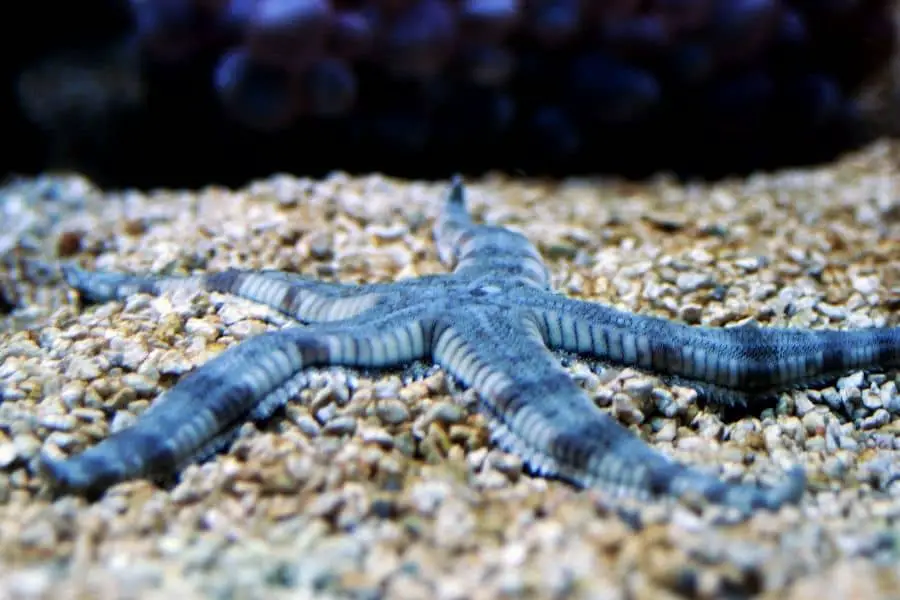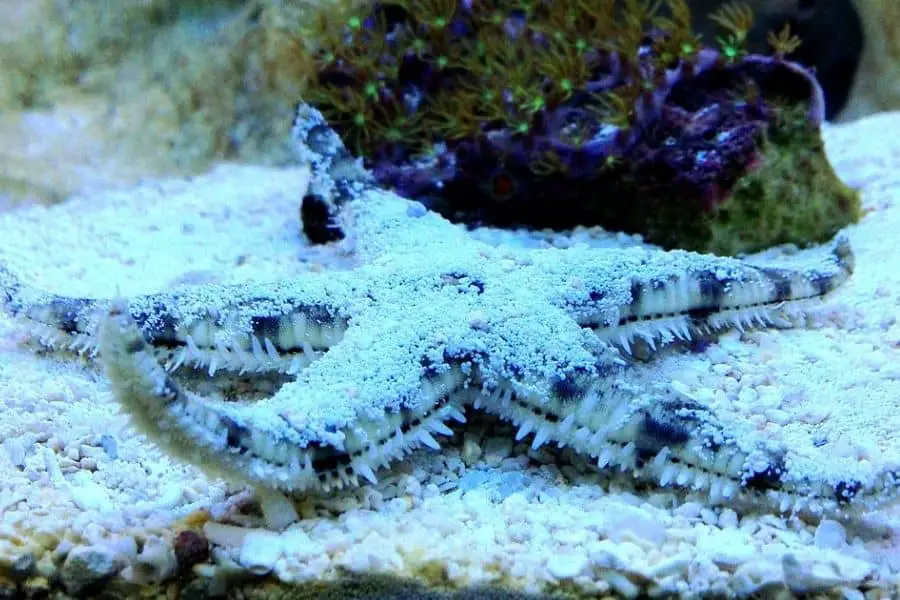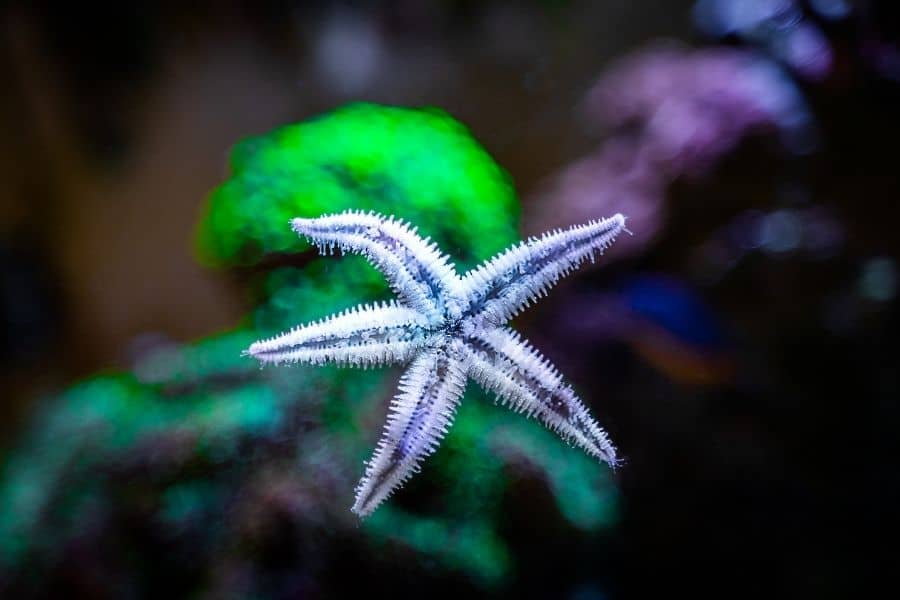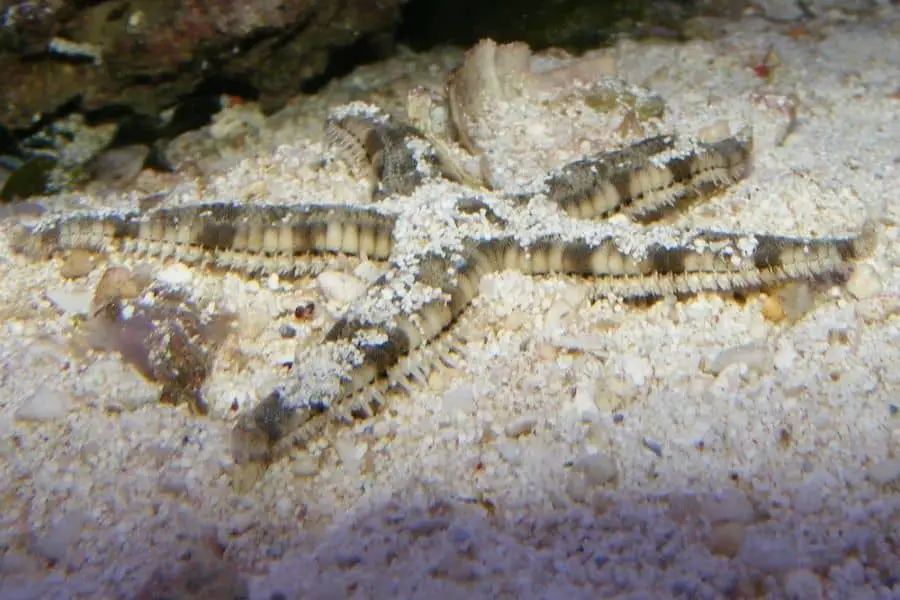Many marine reef tank owners like myself, own Sand sifting starfish in our aquariums for a reason. Believe it or not, they can clean your reef tank immediately and it is an important aspect of their behavior. Hopefully, by the end of the article, you’ll feel confident adding them to your collocation too.

Quick Summary
Jump To
- 1 Quick Summary
- 2 One look Care guide
- 3 Get to know them
- 4 Tank requirements
- 5 How to place them in a tank
- 6 How to acclimate Sand sifting starfish
- 7 How to breed them
- 8 How fast do sand-sifting starfish grow?
- 9 What do sand-sifting starfish eat?
- 10 How to feed them
- 11 Predators of sand-sifting starfish
- 12 Who are the tank mates of sand-sifting starfish?
- 13 Is sand sifting starfish good or bad for your aquarium?
- 14 How many sand-sifting starfish are suitable for a 10-gallon tank?
- 15 Why are starfish dying?
- 16 Are sand-sifting starfish reefs safe?
- 17 Why are sand-sifting starfish legs/arms lost?
- 18 Why are sand-sifting starfish not moving?
- 19 Related topics
Sand sifting starfish (Astropecten polycanthus) is an amazing saltwater creature. They belong to the Astropectinidae family. As all starfish are invertebrates, they do not have a backbone. Sang sifting starfish have five arms and a central disk. These hard five arms situate like a star. There are brown color markings on their thick arms and some hard spines on them. They use their arms to go from one place to another and bury sand substrates.
These arms are flexible and help to catch prey. Their mouth is situated on the underside of the central disk. This starfish got this name because of their sand sifting behavior. They like to live just a few inches down from the sand substrate. Moreover, their average life span is 3-5 years. Generally, aquarists love to add sand-sifting starfish to their aquariums. The most important factor is they can consume mass amounts of detritus.
Because of that, starfish are used as tank cleaners. In captivity, they eat plant detritus, uneaten foods, etc. It helps to reduce excess waste and maintain the water quality parameters of the tank. Also, you can grow sand-sifting starfish in a community tank. They help to enhance the diversity of your tank. Moreover, it is easy to rear in a saltwater aquarium. Because they show a peaceful temperament.
When considering their feed requirement, they are omnivores. Thus, they can eat animal matter, plant matter, and algae.
The pH value, temperature, and water hardness should be at the ideal level to grow healthy sifting starfish for a long time.
So in nutshell, they are a great addition to your aquarium.
One look Care guide
| Scientific name | Astropecten polycanthus |
| Common names | Comb Starfish, White Starfish, and Sand Starfish |
| Care level | Easy |
| Reef Compatible | Reef safe |
| Native to | Pacific region – Fiji, Soloman Island, |
| Type | Starfish |
| Color | Tan, Brown |
| Tank size | Minimum 10 gallons/40 liters |
| Preferred temperature | 72-78o F |
| pH | 8.1-8.4 |
| Ammonia, Nitrate, Nitrite | Zero level (0) |
| Preferred salinity | 1.023-1.025 |
| Water Hardness | 8-12 dKH |
| Size | 75 gallons |
| Growth rate | Slow |
| Temperament | Peaceful |
| Recommended tank mates | Tangs Angels Dwarf Angels Anthias fish Clownfish Butterflyfish Marine crab varieties Marine shrimp varieties |
| Predators | Pufferfish Box fish Trigger fish Parrot fish |
| Preferred food | Squid pellets Algae pellets Sinking fish pellets Meat particles Seafood particles |
| Feeding frequency | 3 times per day |
| Breeding | External Fertilization |
Get to know them

They are native to Indo pacific and the southeast Atlantic Oceans. Moreover, they hang around the rock areas and live under a few inches of sand. Sand sifting starfish have five arms and because of that, they look like a star. They are bottom dwellers and inhabit the sandy bottoms of the ocean. Thus, they got this common name. Like other bottom dwellers, their body is drably colored. The brown bands are situated on their arms and it gives a unique beauty to them.
Moreover, sand-sifting starfish arms are covered by hard spines. Those sharp marginal spines situate along the edges of five arms. Those are pale in color. The arm can grow up to its maximum of 3.5-4 inches. They can reach around 12 inches in their natural habitat. But in captivity, they do not have the ability to reach this size. Sand sifting starfish can live around 3-5 years. Some records mention some of them can live around 10 years.
Tank requirements
Size of the tank
You need to have at least 10 gallons (40 liters) tank to rear them. But larger tanks are much better. Because it allows them to live peacefully and without territory issues in large tanks. If you have 75-100 gallons, it is ideal for them.
Water quality
It is a critical factor for Sand sifting starfish. If oxygen level, salinity, and pH fluctuate, they will die. Moreover, copper-based medicines are badly affected starfish. Hence, avoid using these chemicals in their environment.
Temperature
The ideal temperature is 72-78 Fahrenheit. You should maintain the water temperature at a constant level. Because Sand sifting starfish is extremely sensitive to environmental parameters. They cannot tolerate sudden temperature fluctuations. An Aquarium heater is the best equipment that you can use to maintain the water temperature at a steady level. Install Aquarium Thermometer in the tank to check the temperature regularly.
pH
The ideal pH value is 8.1-8.4 for sand-sifting starfish. Naturally, they live in slightly alkaline water. In captivity, they prefer the same conditions.
Salinity
The salinity level should be 1.023-1.025 specific gravity (32 – 33 ppt). The specific gravity of water can be measured by using a Hydrometer. Salinity is the major factor for saltwater species. Because it directly affects starfish osmoregulation. If any fish lose their osmoregulation balance, they will die.
How to prepare 1.023-1.025 specific gravity (35 ppt) solution
- Take treated tap water (Dechlorinated tap water, because chlorine is toxic to marine organisms)
- Add 35 grams of aquarium salt per one liter
- Mix water and salt properly
- The prepared solution can use to rear marine habitats in captivity
Flow rate
They like to spend quiet and calm life in tanks. You need not supply any special flow rate to them. They do not prefer filtration systems that have a high flow rate. Because it will disturb their peaceful behaviors.
Lighting
Sand-sifting starfish always try to live beneath the sandy substrates. They bury a few inches in it. Thus, they do not need any special light requirements.
Substrates
Do not add many obstacles such as rocks into the tank. Because Sand sifting starfish are unable to get over these obstacles and ornaments. They require a deep sand bed to live in. The sand bed provides;
- Habitat for the Sand sifting starfish’s prey organisms
- Cover for the Sand sifting starfish
- Facilitate constant movement of starfish

How to place them in a tank
These starfish live a few inches under the sandy bottom. Thus, your tank should have a sandy substrate to provide habitat for them. Like other invertebrates, Sand, sifting starfish cannot survive sudden environmental fluctuation. Thus, you should acclimate them before adding them to the aquarium. It is the key factor that reduces the stress of starfish and successful relocation.
Use the drip acclimation method for starfish. The drip method is quite more advanced than the floating bag method. The drip method applies to the most sensitive species such as shrimp, corals, sea stars and wrasses. Do not expose Sand sifting starfish to air while you are handling them.
How to acclimate Sand sifting starfish
- Take a clean 3 or 5-gallon bucket or container, Fill the half of bucket using treated water (dechlorinate water)
- Adjust the salinity level of water around 1.023-1.025 (specific gravity) using aquarium salt (35ppt)
- Dim the lights of the room when the shipping box opens. (Do not remove packages under high light intensity)
- Float the fish bag on the bucket/container. Allow 20 minutes to soak that fish bag in the bucket of water, then starfish will acclimate to the temperatures of the outer environment
- Carefully add starfish to the bucket with the water of that starfish live
- Important: Do not expose sensitive invertebrates to the air
- You can angle the bucket. It facilitates enter new organisms easily into the new environment
- Use an airline tube to transfer the main tank water to the bucket.
- Connect airline regulators to control the water passing rate. (You can adjust it using a regulator or add knots in the air supplying valve)
- They dip one corner of airline pipes in the main aquarium and suck water from the other ends of airline pipes
- The water supply rate should be 2-4 drips per second. When the water volume of the bucket is double, discard half of the water from the bucket
- Again add the airline pipe into the bucket and the water flow rate should be the same
- The volume of water will double after about one hour. After one hour you can transfer your sand sifting starfish into the main aquarium
- Do not directly expose your starfish to the air. Placed your bag underwater in the bucket
- Enter your specimen into that plastic bag, Turn off the lights of the main aquarium for 3,4 hours
- Gently remove the bag from the water bucket and placed it under the water of the main aquarium. Seal off the bag and release your starfish to your main tank
The most important thing, you should be patient when doing acclimating procedures. You should have spent around one hour acclimating.
How to breed them
Breeding sand sifting starfish is quite difficult in reef aquariums or in captivity. You need expert knowledge to identify male and female starfish. Because they have the same physical appearance.
In the wild, they do only one breeding per year.
- The female starfish lay around a 2.5million eggs in the water column
- The male starfish release their sperm and fertilized the eggs
- It is the external fertilization
- These eggs are associated with planktonic soups
- Zygotes develop and become small individuals
- Those individuals settle on the substrate
- Sand sifting starfish larvae are eating plankton varieties

How fast do sand-sifting starfish grow?
Sand sifting starfish can reach 12 inches wide. Normally, 2 inches wide starfish are available in the aquarium shops. In captivity, they grow quite slowly. They reach 8 inches maximum in the tank.
What do sand-sifting starfish eat?
Sand sifting starfish is an omnivore. In the wild, they eat small invertebrates. These are Small starfish, shrimps, urchins, mollusks, and bivalves. This starfish is a famous tank cleaner. Some aquarists add them to their tanks because of this feature. You can add a varied diet to them. If not they will eat tank detritus immediately and bury it under the sandy bottom.
Generally, Sand Sifting Starfish do need a large quantity of food per day. If your tank has not have that much food it will burrow in the deep sand and starve. Thus, make sure to provide supplemental food when natural foods are not enough. The most preferable foods are;
- Detritus
- Bivalves
- Small sea stars
- Urchins
- Worms
- Snails
- Tiny brittle stars
- sea cucumbers
- Shrimp
- Small crustaceans
- Mollusks
- Amphipods
- Copepods
In the aquarium, you can provide formulated, frozen, freeze-dried, and live fish foods to sand-sifting starfish. You can provide;
- Squid pellets
- Algae pellets
- Sinking fish pellets
- Meat particles
- Seafood particles
Brine shrimp are suitable for feeding baby Sand sifting starfish. Make sure that they have enough food to eat. If not they will begin to decay eventually.
How to feed them
Feeding frequency
If there is not enough food in the sand, they will start to climb up the glass of the tank. It is a good sign to understand the supplement food requirement. You can feed two or three times per day to overcome this issue. Because when they starve, they will immediately decompose and die.
Predators of sand-sifting starfish
They are a slow-moving species. Thus do not add predatory species with them, because they will be prey for them. The sand-sifting fish’s predators are;
- Pufferfish
- Shark
- Trigger Triggerfish
- Box fish
- Parrot fish
Who are the tank mates of sand-sifting starfish?
You can rear Sand sifting starfish in marine water, in a community tank. Because they are peaceful organisms. Peaceful fish varieties, semi-aggressive marine creatures, corals, and other invertebrates can grow up with starfish.
The fish and invertebrates varieties perfectly match as sand-sifting starfish tankmates.
- Tangs
- Angels
- Dwarf Angels
- Anthias fish
- Clownfish
- Butterflyfish
- Marine crab varieties
- Marine shrimp varieties
Is sand sifting starfish good or bad for your aquarium?
As mentioned above they are good tank cleaners. Thus, Sand sifting starfish can play a major role in your reef saltwater tank. They help to reduce waste and maintain water quality at a pristine level. Moreover, they add unique beauty to your aquarium and diversify your community tank. Because of their peaceful nature, they can be added with other marine fish varieties too. Further, rearing them in the aquarium is easy. Hence adding them to the aquarium is beneficial for the aquarist.
How many sand-sifting starfish are suitable for a 10-gallon tank?
Sand sifting starfish are always seeking food particles. You can add one-star fish to the 10-gallon tank. If you want to add a pair of these starfish to your aquarium, you need a large tank. Because they mainly depend on tank detritus. If the natural food is not enough for them, they will burrow into the sand and begin decaying.
Anyhow, if you want to rear two starfish in a 10-gallon tank, provide enough supplementary food to them. Because natural foods that are available in a 10-gallon tank will not be enough for two starfish.
Why are starfish dying?
They are fast feeders. Sand sifting starfish eat available food particles and detritus speedily. After that, there is not enough food to eat. In this situation, they feel starved and borrow under the sand bed. The final result of starvation is death. Poor acclimate procedures can be a major reason for their death.
Because of that, you should follow the correct procedures when adding sensitive invertebrates into the tank. Do not expose sand-sifting starfish into the air for any reason. Because they cannot survive without water. Further, rapid fluctuation of environmental parameters, non-treated water, and predatory pressure can kill your starfish.
Are sand-sifting starfish reefs safe?
Yes. Sand sifting starfish is reef safe. You can add them to your reef tank. It will give lots of benefits by cleaning the tank detritus. Moreover, they do not eat coral and do not damage coral reefs.
Why are sand-sifting starfish legs/arms lost?
Because of inadequate nutrition, sand-sifting starfish legs can lose. Hence, you should provide enough food for them. Losing their arms/legs is a sign of their death.
Why are sand-sifting starfish not moving?
The main reason can be the bad health conditions of sand sifting starfish. You can check whether they are dead or not by doing the following steps.
- Lift them from sand
- Turn them upside down in the water
- Watch their response of body or tentacles
- Observe them for a few minutes
If there is any movement,
- Put them back where sand-sifting starfish live
- Add target feed like quality algae wafers, squid pellets, and blood worm pellets into the tank bottom
- Add sufficient feed for everyday
- Keep your eye on starfish until they become normal
If sand sifting starfish have not any movements,
- They are dead. Thus, remove them from the aquarium. Because if starfish deteriorate in the tank, it will produce a high level of ammonia.
- High levels of ammonia are not good for other reef fish and corals that exist in aquarium
Related topics
Are sand sifting starfish poisonous to us?
Sand sifting starfish is poisonous to humans. Do not consume them as raw or processed food. They contain neurotoxin and tetrodotoxin.
These neurotoxins also include in Puffer fish, some Angelfish varieties, and Ribbon worms.
Neurotoxin and tetrodotoxin are extremely poisonous to humans. These poisonous chemicals can adversely affect nervous tissues.
It can inhibit the cellular function of the human body. Symptoms will show within 30 minutes.
The major symptoms are nausea, diarrhea, vomiting, and abdominal pain. Death will occur after the failure of the humans’ respiratory system.
Are sand sifting starfish Hardy?
Sand sifting starfish is not significantly hardy. But they cannot tolerate sudden environmental parameter changes.
Keep water temperature, PH, Salinity, and oxygen level at an optimum and constant level. Moreover, you need to supply 4,5 inches deep sandy bottom to inhabit them.
Some people use medicines that consist of copper. But copper is not good for your starfish.
Therefore, if you want to give copper treatments for any fish, separate that fish from the main tank.
Do sand sifting starfish eat algae?
Yes, Sand sifting starfish eat algae. This starfish is an omnivore. Thus, they can ingest any food material as food. Moreover, they mainly depend on tank detritus. Detritus includes algae particles.
Why sand sifting starfish climbing glasses?
It is a normal thing. When they require more food they climb on glass and search for food. Because they are fast eaters and always searching for something to eat. But your power head can kill them when they climb.
Hence, you should pay attention to this and install a power head at a place that your starfish cannot access easily.
Do Starfish clean tanks?
Yes, Sand sifting starfish is a good tank cleaner. They are associated at the tank bottom and like to live in a sand bed environment.
They eat tank detritus and uneaten food quickly. It will also help to maintain the water quality parameter of the tank.
Uneaten food particles are the main source of ammonia. A high level of ammonia, nitrate, or nitrate can kill your fish and coral reefs.
This wonderful creature helps to remove excess food immediately and clean the water.
Sand sifting starfish price?
The small size (1 inch- 1.5 inch) sand sifting starfish’s price will be around $30.
Read More : Rock Flower Anemone | Beautiful rock flowers to your aquarium |
